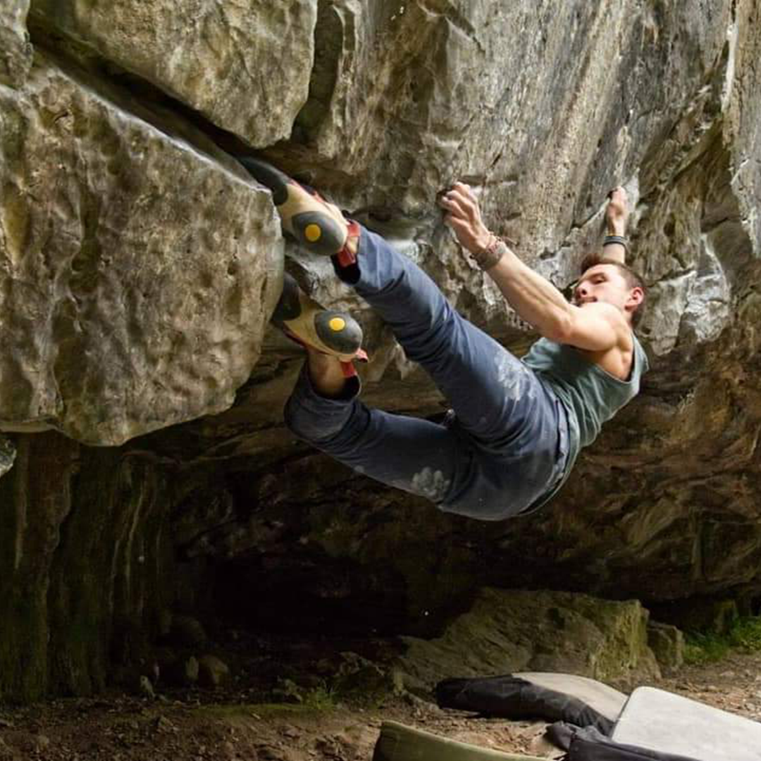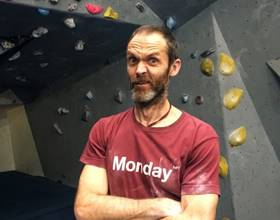
Your man on the ground
The area around the Swansea Hangar has always been known for the soaring sea cliffs of Pembroke and the exciting weathered limestone cliffs of the Gower. But there’s a helluva a lot of bouldering to be done around these parts, much of which has yet to find its way into the guidebooks.
Luckily, Hangar Swansea’s Rich spends his spare time out in nature’s playground sampling local rock. We managed to track him down for some insider insights into bouldering spots around Swansea.
Bear in mind that many of the coastal crags are tidal, check the tide times before you head out and make sure you keep one eye on the time!
It’s my first time bouldering outdoors…
The Gower has always been known for its outstanding scenery, but it has certainly seen a rise in popularity in recent years. To be honest we’re not really that surprised, with trad, sport, deep water soloing and bouldering available right there on the beach… Why do you think we moved in just up the road?
The Sewerpipe area on the Gower Peninsula (don’t be put off by the name) is Rich’s top pick for your first trip out on real rock. The wealth of problems from f4 – f5s (that’s V0-1) provide the perfect transition into climbing outdoors, giving you the opportunity to rack up the mileage and get accustomed to the style of climbing on real rock. A chilled setting makes it ideal for climbing with children or animals too, and a swim is always on the cards! Sewerpipe is only 20 minutes from Swansea, making it one of the closest coastal bouldering spots to the city centre (although there is some buildering to be done in Swansea Bay).
Sewerpipe is tidal; the whole area is above water 2.5 hours either side of low tide. For approach notes and topos, visit the South Wales Mountaineering Club Wiki. If you want to log your sends on UKClimbing.com, Sewerpipe is listed under Limeslade Crags.
I’m looking for somewhere easily accessible…
Just a 20 minute drive from Swansea (25 minutes from the Hangar), Caswell Bay is best known its busy beaches, accessible slabby trad climbing and 5 minute walk-in. It goes without saying that this isn’t a place to escape from it all, but it is a place where you can find tonnes of bouldering in the f4 – f6A (V0 – V3) range without having to walk very far. Ideal for beginners, those who are looking for a first project to get their teeth should definitely try Super Arete! Areas at the bottom of the beach are tidal, but the White Wall at the top isn’t. The topo is available on the South Wales Climbing Wiki.
I don’t want to see another climber!
If it’s some peace and quiet you’re after, head about 50 minutes east of Swansea and you’ll find a small haven for esoteric boulderers at The Little Gap. 20 problems on hard inland sandstone with excellent friction can make a welcome change from the usual sea of limestone, with far more problems yet to be unearthed.
For a little less esoteria but just as much sandstone, Clogfaen Gigfran is just down the road with 80 problems ranging from f3 – f7B+ (VB – V8). Fairly sheltered, both crags stay dry enough in wet weather but tend to be a bit greasy after rain. Being far from the sea and unaffected by the tide, these crags are ideal for after-work bouldering. The topo for Clogfaen Gigfran is available on the South Wales Bouldering Guide Wiki, head over to UKC for details on The Little Gap.
I want to try really really really hard!
Rich’s stomping ground is Dinas Rock. Best known for its excellent quality limestone and fierce sport routes, there’s plenty of hard bouldering to get your teeth into with a smattering of problems in the f4 and f5 (V0 – V1) region. Rich likes it because it’s steep, solid and has a short walk-in; although its proximity to his house and Hangar Swansea helps too (perfect for getting that after-work climbing fix in). Dinas Rock stays fairly dry in the wet weather so it’s a good spot on a rainy day, but it does suffer seepage after a downpour.

Rich Marotta pictured above climbing The Riot 7C+. Image courtesy of "darkcorevisuals"
Topos are available on the South Wales Mountaineering Club Wiki, and an extra detailed topo of the Kennelgarth Wall area can be found here.
A few resources for outdoor boulderers
Check these out before you head outside
- UKC – for finding crags and logging climbs
- South Wales Wikis – SWMC, SWCW and SWBG have comprehensive topos (guides) for South Wales bouldering and climbing.
- BMC RAD – for checking access and restrictions (ie. Nesting bans).
- Tide forecast – everyone has their favourite, although this one comes highly recommended by climbers.
- Kieran’s guide to bouldering outside – for brushing up on your crag etiquette and outdoor technique

